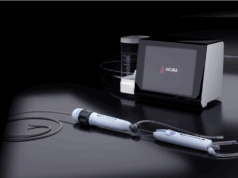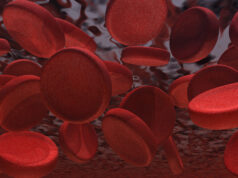
Peter H Lin
Pulmonary embolism in children is a potentially lethal condition and yet is a vastly understudied arena. Autopsy studies show a higher prevalence of pulmonary embolism compared to medical database registries suggesting that this condition is often clinically under-recognised. As a manifestation of venous thromboembolic disease, the incidence of paediatric pulmonary embolism continues to rise as successful management of previously untreatable malignancies, complex congenital cardiac conditions and usage of central venous catheters increases.
Although systemic thrombolysis and embolectomy are effective at thrombus resolution, these treatments are associated with significant haemorrhagic complications. Catheter-directed thrombolytic (CDT) therapies have been shown to be effective and safe when compared to systemic thrombolysis in adults. Novel techniques such as ultrasonic accelerated CDT (UCDT) have been shown to achieve faster and more complete clot resolution with lesser complications than CDT alone in adults. However, paediatric studies assessing efficacy and safety of CDT or UCDT for pulmonary embolism are largely absent in the literature.
A clinical study was conducted by our team, in which we examined the clinical experience of paediatric patients diagnosed with either acute massive or submassive pulmonary embolism who underwent catheter-directed thrombolytic therapy at the Texas Children’s Hospital. During a recent eight-year period, a total of 22 paediatric patients were treated with catheter-directed thrombolytic therapy for either acute massive pulmonary embolism (n=18, 82%) or submassive pulmonary embolism (n=4, 18%). All patients had computed tomography of the chest which confirmed their diagnosis. Among them, CDT was used in the first 10 patients (45%), while UCDT using the EkoSonic Endowave System (BTG) was performed in the most recent 12 patients (55%). Risk factors for pulmonary embolism included morbid obesity (body mass index [BMI] >40) in four patients (18%), obesity (BMI >30) in 10 patients (45%), hypercoagulable disorder in five patients (23%), and lower extremity deep vein thrombosis in the remaining three patients (13%). The median age of patients treated was 14.5 years (range: nine years to 17 years). The indication for CDT was complete occlusion of the main or major branch pulmonary arteries with either hypotension or right ventricular dysfunction. CDT was performed via access of femoral vein through which a catheter (5–7F) was placed in the affected pulmonary artery and recombinant tissue plasminogen activator (tPA) was delivered at the thrombus site. UCDT involved ultrasonic pulses delivered by the EkoSonic system along with targeted delivery of tPA. Hypotension and need for vasoactive support existed in 17 (77%) cases. Echocardiographic findings were abnormal in all patients. These included depressed right ventricular function with mild to moderate tricuspid regurgitation in 18 patients (82%) and four patients (18%) had right ventricle strain or hypokinesis prior to intervention. All patients needed supplemental oxygen with four (18%) being mechanically ventilated prior to intervention. Thirteen patients (59%) underwent bilateral pulmonary thrombolytic therapy via bilateral femoral venous access while the remaining nine patients (41%) underwent unilateral pulmonary embolism intervention.
Complete resolution of thrombus was demonstrated within 24 hours in 18 patients (82%), and partial resolution occurred in four patients (18%). One patient who had complete resolution of pulmonary embolism at 24 hours after treatment presented with recurrent pulmonary embolism four months later, and underwent another successful UCDT procedure. Cardiorespiratory parameters improved after the intervention. All patients had normalisation of right ventricular function on echocardiography, post intervention. Median duration of hospital stay was 10 days (range: 7–42 days). There was no mortality or procedural complication.
The recent scientific statement from the American Heart Association recommends initiation of anticoagulation at initial suspicion of pulmonary embolism, and commencement of systemic thrombolysis when right ventricular dysfunction exists. CDT is suggested for patients with massive pulmonary embolism with contraindications to systemic thrombolysis and as a salvage therapy. For submassive pulmonary embolism, CDT is suggested as a consideration for patients with clinical evidence of adverse prognosis, but is not recommended for patients with low-risk pulmonary embolism.
CDT provides the potential advantage of acutely decreasing the thrombus burden with resultant decease in right ventricle afterload and improvement of haemodynamics. Much smaller doses of thrombolytic agents are used in CDT, leading to fewer complications. Furthermore, adult case series have described various mechanical means used in conjunction with pharmacologic therapies during CDT (pharmacomechanical CDT). Ultrasonic agitation with CDT (UCDT) has also been used in an effort to dissociate fibrin strands and facilitate dissemination of the thrombolytic agent through the clot. UCDT allows for use of lower doses and shorter infusions of thrombolytics, thereby minimising adverse effects. The EkoSonic system involves a drug-delivery catheter with multiple lumens and infusion ports. Ultrasound energy is generated by an external control unit and is delivered by small transducers uniformly along the infusion system.
In our series, all patients had some form of right ventricular dysfunction, signifying severe (submassive or massive) pulmonary embolism, and were thus felt to be suitable candidates for catheter-based therapies. These interventions achieved good outcomes with respect to thrombus resolution, haemodynamic stabilisation and improvement of right ventricular function. CDT/UCDT may thus be useful when used judiciously for paediatric patients with severe pulmonary embolism. These interventions appear to be safe and efficacious in skilled hands and provide alternatives to systemic thrombolytic therapy. While short-term follow-up with echocardiogram demonstrated resolution of right ventricular dysfunction, long-term studies to evaluate the effect of cardiac function are warranted. Our study suggests either CDT or UCDT remains an effective treatment modality in massive or submassive pulmonary embolism in the paediatric population.
Peter H Lin is professor emeritus of Surgery, Division of Vascular Surgery & Endovascular Therapy, Michael E. DeBakey Department of Surgery, Baylor College of Medicine, Houston, USA









